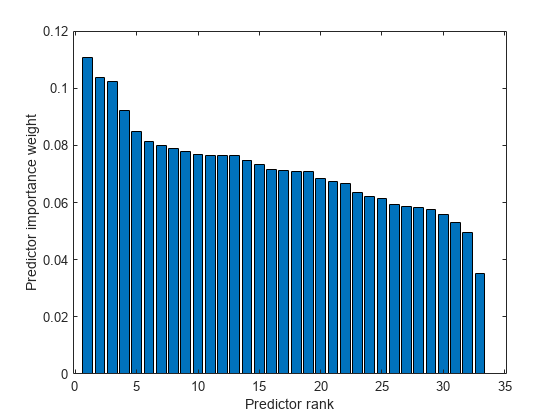relieff
Rank importance of predictors using ReliefF or RReliefF algorithm
Description
[
ranks predictors using either the ReliefF or RReliefF algorithm with
idx,weights] = relieff(X,y,k)k nearest neighbors. The input matrix
X contains predictor variables, and the vector
y contains a response vector. The function returns
idx, which contains the indices of the most important
predictors, and weights, which contains the weights of the
predictors.
If y is numeric, relieff performs
RReliefF analysis for regression by default. Otherwise, relieff
performs ReliefF analysis for classification using k nearest
neighbors per class. For more information on ReliefF and RReliefF, see Algorithms.
Examples
Input Arguments
Name-Value Arguments
Output Arguments
Tips
Predictor ranks and weights usually depend on
k. If you setkto 1, then the estimates can be unreliable for noisy data. If you setkto a value comparable with the number of observations (rows) inX,relieffcan fail to find important predictors. You can start withk=10and investigate the stability and reliability ofrelieffranks and weights for various values ofk.relieffremoves observations withNaNvalues.
Algorithms
References
[1] Kononenko, I., E. Simec, and M. Robnik-Sikonja. (1997). “Overcoming the myopia of inductive learning algorithms with RELIEFF.” Retrieved from CiteSeerX: https://link.springer.com/article/10.1023/A:1008280620621
[2] Robnik-Sikonja, M., and I. Kononenko. (1997). “An adaptation of Relief for attribute estimation in regression.” Retrieved from CiteSeerX: https://www.semanticscholar.org/paper/An-adaptation-of-Relief-for-attribute-estimation-in-Robnik-Sikonja-Kononenko/9548674b6a3c601c13baa9a383d470067d40b896
[3] Robnik-Sikonja, M., and I. Kononenko. (2003). “Theoretical and empirical analysis of ReliefF and RReliefF.” Machine Learning, 53, 23–69.
Version History
Introduced in R2010b
See Also
fscnca | fsrnca | knnsearch | pdist2 | sequentialfs | plotPartialDependence | fsulaplacian | fscmrmr | fsrmrmr
